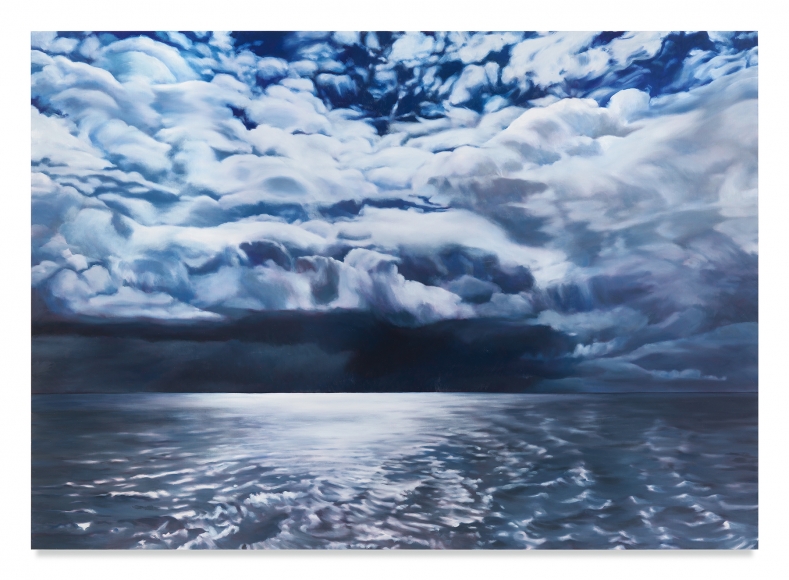The art of the Group of Seven continues to shape Canada today. We took a closer look: Here are five contemporary landscape painters we love!
Landscape paintings have been around almost since the dawn of mankind. They got more elaborate in the 15th century and really bloomed during the Romantic movement in the 19th and 20th century. In Canada, the famous Group of Seven used landscape paintings – colorful, serene scenes of untouched nature, even though it was not untouched and empty, but populated by Indigenous people – to consolidate the character of their new-found state. Even today, contemporary artists use landscape paintings in various forms: as a vehicle to change the past, as commentary on climate change, as a way to evoke emotions. Here are five contemporary landscape painters we love!
1. Kent Monkman / Miss Chief Share Eagle Testicle
Monkman is an interdisciplinary Cree visual artist who lives and works in Dish With One Spoon Territory (Toronto, Canada). He mimics the style of classic, Old Masters of the 19th century Romantic period, but alters history by reversing roles, changing animals into white men, and including his trickster alter-ego Miss Chief Share Eagle Testicle, a gender-fluid two-spirit character whose name is a cheeky play on mischief, Cher (the queer music icon), and egotistical. Two-spirit is a third gender, spiritual role unique to Indigenous cultures from North America that has been almost erased by colonialization. Share helps the arist to reverse the Western gaze on Indigenous cultures and to convey his themes of „colonialization, sexuality, loss, and resilience“ to the audience through painting and performance.

Kent Monkman, Miss America, 2012, Collection of Musée des Beaux-Artes de Montréal, Courtesy the artist, Image via heard.org
2. Wanda Koop
Wanda Koop is one of the most distinguished artists of contemporary Canada. She has lived most of her live in Winnipeg, Manitoba and works at the intersection of urbanization, technology, and the natural world – redefining the landscape painting genre for more than 40 years. Her large-scale paintings combine pristine colorful landscapes, almost too flat to be real, and some kind of breaking element: be it colorful drips, graphic shapes, or barcodes, working as a subtle reminder of humanity’s intervention, yes, destruction of nature. Koop is also working as a relentless activist for the arts, founding her own community art center, trying to bring contemporary art to the local youth.

Wanda Koop, SEEWAY FLOE, 2019, Courtesy the artist, Image via bonavistabiennale.com
3. Curtis Van Charles
Van Charles studied graphic design at the Alberta College of Art and Design, but he always wanted to be a painter. In his practice he combines both: he digitally cuts and rearranges photographies of his subjects, his favorite Canadian flora and fauna, before he starts painting. Sometimes he even incorporates some of the graphics in print form into the pieces itself. He created one of the inaugural murals for the Beltline Urban Murals Project (BUMP), a community driven initiative transforming the city center of Calgary, Canada, into a public art, open air gallery since 2017. At the beginning of his career Van Charles wanted to inspire his audience to enjoy the great outdoors, but recently he started to incorporate glaciers and ice bergs into his pieces to start a desperatly needed conversation on the effects of climate change.

Curtis Van Charles, Beltline Urban Murals Project (BUMP) Calgary, AB, Courtesy the artist, Image via www.vancharlesart.com
4. April Gornik
Her large-scale, realist landscape paintings recall themes of Romantizicm, Symbolizm, and Feminism and still leave tremendous room for interpretation. April Gornik has been trained in Nova Scotia, CA at the Nova Scotia College of Art and Design in the 1970s and has lived with her husband on the East End of Long Island, NY over the past three decades. Even though she never confirmed being an environmental artist, she is not opposed to people reading a message on climate change and preservation of nature into her pieces. Her work is in the collection of major museums such as The Metropolitan Museum of Art, the Museum of Modern Art, and The Whitney Museum of American Art, as well as private collections. She is an avid community activist and has recently converted a former church into a community art center and artists residency.

April Gornik, Sea of Light and Dark, 2019, Courtesy the artist, Image via www.aprilgornik.com
5. Hernan Bas
Bas was born and raised in Miami and moved to Detroit, citing that he loves the quirkiness of the city. His fascination for the paranormal as well as the Romantic era, for its glorification of nature, and the Decadent movement surrounding French writer Charles Baudelaire, evoking romantic nihilism and excess, have seeped into Bas‘ work. His paintings are dominated by adolescent male figures, brooding in dark, otherworldly almost surreal landscapes. His practice involves excessive research into topics and other artists, sampling and remixing their works until they’re unrecognizable and the piece becomes uniquely his. He has been exhibited internationally from Paris to South Korea, including the group exhibition New Worlds – New Romanticism in Contemporary Art at the SCHIRN.

Hernan Bas, A boy in a bog, 2010, Courtesy der Künstler und Victoria Miro Gallery, London, Foto: Nicola Kuperus, Image via www.kunstverein-hannover.de
MAGNETIC NORTH. IMAGINING CANADA IN PAINTING 1910–1940
Only until 29 August 2021!









